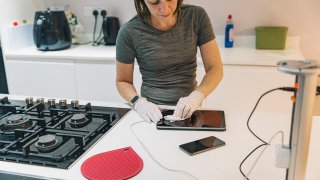
A new study shows that COVID-19 remains for several hours to days on surfaces and in aerosols, and suggests that people may acquire it through the air and after touching contaminated objects, officials at UCLA announced.
The study published in the New England Journal of Medicine suggested the virus is detectable for up to three hours in aerosols, up to four hours on copper, up to 24 hours on cardboard and up to two to three days on plastic and stainless steel.
"This virus is quite transmissible through relatively casual contact, making this pathogen very hard to contain," said James Lloyd-Smith, a co-author of the study and a UCLA professor of ecology and evolutionary biology. "If you're touching items that someone else has recently handled, be aware they could be contaminated, and wash your hands."
The study attempted to mimic the virus being deposited onto everyday surfaces in a household or hospital setting by an infected person through coughing or touching objects, for example. The scientists then investigated how long the virus remained infectious on these surfaces.
The study's authors are from UCLA, the National Institutes of Health's National Institute of Allergy and Infectious Diseases, the Centers for Disease Control and Prevention, and Princeton University. They include Amandine Gamble, a UCLA postdoctoral researcher in Lloyd-Smith's laboratory.
In February, Lloyd-Smith and colleagues reported in the journal eLife that screening travelers for the coronavirus is not very effective. People infected with the virus may be spreading it without knowing they have it or before symptoms appear, according to researchers.
Lloyd-Smith said the biology and epidemiology of the virus make infection extremely difficult to detect in its early stages because the majority of cases show no symptoms for five days or longer after exposure.
Local
Get Los Angeles's latest local news on crime, entertainment, weather, schools, COVID, cost of living and more. Here's your go-to source for today's LA news.
"Many people won't have developed symptoms yet," Lloyd-Smith said. "Based on our earlier analysis of flu pandemic data, many people may not choose to disclose if they do know."
The new study supports guidance from public health professionals to slow the spread of COVID-19:
-- Avoid close contact with people who are sick;
-- avoid touching your eyes, nose and mouth;
-- stay home when you are sick;
-- cover coughs or sneezes with a tissue, and dispose of the tissue in the trash; and
-- clean and disinfect frequently touched objects and surfaces using a household cleaning spray or wipe.



